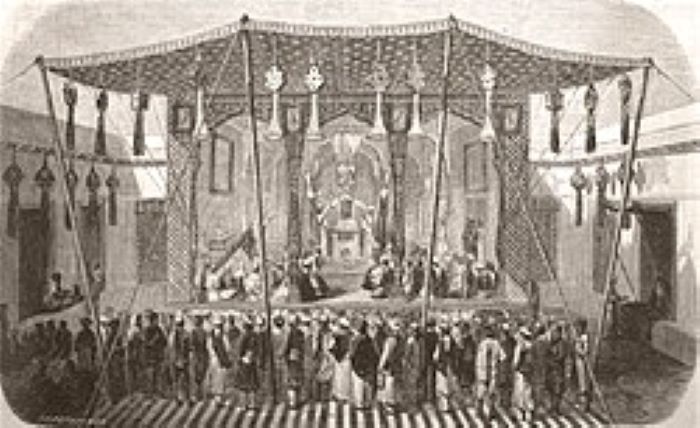History of Shi’ism in India
You are Here: Tweet, Like, Share, Comment, Subscribe…be the Voice of Free Press!
First Published on: Jun 17, 2021
By Syedda Shahid, Edited By Adam Rizvi, The India Observer, TIO: The legacy of Shi’ism in India, home to the second-largest Shia population in the world after Iran yet so heavily under-represented in the diaspora.
With Muhurrum, the mourning month just around the corner which kicks starts from the evening of Thursday, August 20th, Ashura (10th day of the Muhurrum) is a public holiday in India, whilst the birthday of Imam Ali (AS) is a public holiday in at least 2 states, Bihar and Uttar Pradesh. During the ’92 Shia Uprising in Iraq, the media had been tightly controlled by Saddam Hussein yet the channel Doordarshan was the only channel covering the events at that time.
Here is a random list of 10 historically important monuments that contribute to the rich diversity of this land that has been built by the past rulers in India to commemorate Muharram. Similarly, there are thousands of dated Imambargahs spread across every nook and corner of India.
Also Read, Tweet & Share: Muharram, Majalis, Azadari & Marsiya Nigari kay Shahenshah Mirza Salamat Ali Dabeer
1) Charminar is a monument and mosque in Hyderabad, built-in 1591 by Muhammad Quli Qutb Shah of the Qutb Shahi dynasty, a Shia dynasty that ruled the Golconda region of South India for 171 years.
2) The Hooghly Imambargah was completed in 1861 and is located in West Bengal. The clock was manufactured by Messrs E.J. Dent & Co., the same company that manufactured the clock in Big Ben in London.
3) The Nawabs of Murshidabad and Bengal built what is considered to be the largest Imambargah in India, the Nizamat Imambargah in 1847.
4) The Nawabs of Awadh ruled over Lucknow from 1722 to 1859 and left behind beautiful architecture. Here are the Jama Masjid, Asafi Masjid also known as the ‘Bara Imambargah’, and the Hussaini Masjid also known as ‘Chhota Imambargah’
Also Read, Tweet & Share: The legacy of Shi’ism in India
5) The Bahmanids of Deccan converted to the Shi’ism school of thought and their legacy is seen in the ruins of the ‘Mahmud Gawan Madrassah’ built in the 1460s. The Adil Shahi kingdom would break away, and the shrine of Muhammad Adil Shah built-in 1656 exists today.
6) The Rampur Raza Library in Rampur was established in 1774 by Nawab Faizullah Khan is a repository of Indo-Islamic cultural heritage and a treasure-house of knowledge. It contains a very rare and valuable collection of manuscripts, historical documents, specimens of Islamic calligraphy, miniature paintings, astronomical instruments, and rare illustrated works in Arabic and Persian.
One of the priceless books in the library is the unique copies of the Holy Qur’an written on parchments that have been attributed to the penmanship of Imam Ali (AS) in (d 661) of the 7th century AD.
7) Imambargah Gulzarbagh Waqf Estate in Patna was built by Imambandi Begum in 1890 widow of Nawab Ahmad Ali
Also Read, Tweet & Share: Muharram is not about ‘Happy New Year’
8) Shah Najaf Imambarah in Lucknow was built by Nawab Ghazi-ud Din Haider (1814-1827) at a place called Paltan Ghat on the banks of the river Gomti, this Imambara also serves as a mausoleum to the Nawab’s own mortal remains.
9) 700 hundred-year-old Imambargah Shah-e-Mardan located in the Jor Bagh, South Delhi, since Mughal era the village here was known as Aliganj and was called Aliganj till recently until two decades ago by the then Govt changed it to B.K.Dutt colony.
It was developed and secured by Qudsiya Begum Zamani, the mother of Mughal emperor Ahmad Shah Bahadur and the grandmother of the last Mughal emperor Bahadur Shah Zafar.
10) Imambara Wazeer Un Nisa in Amroha, UP was built by Musammaat Waziran in memory of her daughter, it was established before 1802 (1226 Hijri).
 Also Read, Tweet & Share: Reflections on Imam Sajjad (as)
Also Read, Tweet & Share: Reflections on Imam Sajjad (as)
Here is a link to a very interesting and informative documentary produced and directed by the very talented @AmirTaki for @AhlulbaytTV Documentaries known as :
“The Shia of India”
In India many Hindus too commemorate Muharram. Contribution of Maratha rulers such as Holkers of Indore, Gaekwad of Baroda, Scindias of Gwalior Shahu Ji of Kolhapur, the Rani of Jhansi and Tanjavur Nayaks of Vijayanagar in the 16th and 17th century to the observance of Muharram and participation in its rituals with the splendor of royalty in their dominions have been a prominent part of history, the Hindus in Tamil Nadu observe ‘Allah Festival’ on Eve of Muharram and till date, the Sindhia family organizes Tazia, each year the procession is taken out from their palace at Gwalior on 10th day of Muharram.
Also Read,Tweet & Share: Karbala: A Guiding Light for Humanity and the Essence of Islam
Gwalior Palace has been commemorating Muharram for centuries. It was established by Maharaja Jiwajirao Scindia and is famously known as “Maharaja Scindia Ji ka Tazia”
In Vadodara, for more than 200 years Taziya had been installed at Sarkarwada official residence of the Gaekwad royal family and was called Sarkari Tazia under the patronage of the royal family. Tazia of Yakutpura is one of the initial installations that began in the erstwhile state of Baroda
Tazia = representation of the tomb of Imam Hussain (a.s)
There is also a group called Hussaini Brahmins who claim their ancestors participated in the battle of Karbala.
Also Read more from this Author: Aftermath of the Battle Of Karbala
Curated by Humra Kidwai
Articles written by contributors have different viewpoints. The views expressed in the articles are the author’s own and not necessarily supported by TIO, The India Observer its affiliates, staff, or the management. Our Articles can be reproduced, with the following conditions, (1) No alteration to the content, (2) Visible, and full credit is given to the Author & Editor. (3) Citing, The India Observer, TIO. In the case of online or electronic media, a link to the original article must be given. Rules are strictly enforced. Any questions, email the Editor at: Mediaiss@gmail.com Or TheIndiaObserver@gmail.com



